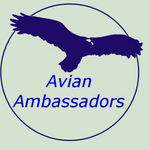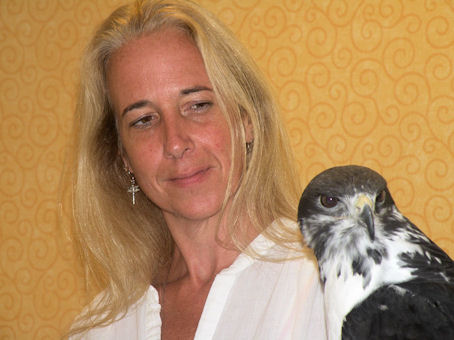I returned from my trip to the IAATE conference in Holland to find a lively discussion going on in one of the yahoo groups for parrot training. The subject of the discussion is one that crops up from time-to-time and it always elicits lively, often polarized views. That subject is the use of food or weight management for training birds. It is also a subject that is often not fully understood by either the vehement supporters or detractors.
When training any animal one of the very first steps is for the trainer to figure out what the animal may find rewarding; this is what the trainer will use as a reinforcer for the behaviors being trained. If one is beginning with an animal that has no training history it is necessary to choose a primary reinforcer. A primary reinforcer is one that does not require any learning on the part of the animal. Primary reinforcers include sleep, food, air, water, and, in the opinions of some, sex. When working with birds the primary reinforcer typically chosen is food. Once the subject understands the training process it may be possible to introduce secondary or conditioned reinforcers such as attention, verbal praise, or access to toys.
While food is a primary reinforcer not all types of food are reinforcing for all birds; just like people birds also have food preferences and an observant trainer can quickly learn the preferred food type of the subject. Once identified this preferred food item can be removed from the daily diet and only offered to the bird as a training reinforcer. This method of training is the one that many companion parrot owners try to begin training their birds and it is also the one that many find to be ineffective, “my bird just isn’t interested in food”.
However, what these trainers forget is that the value of any food item is dynamic, after a large meal even our own preferred food items are less desirable to us. Therefore when using food as a potential reinforcer we need to be sure that the items being offered have real value to the subject at the time they are offered. This does not necessarily mean that we have to reduce the total amount of food offered to the bird; it simply means that by controlling access to food we create the perception, from the bird’s perspective, that food may not be as abundant as it was. Rather than repeat here what has already been very well written on this subject I would like to direct you to a Barbara Heidenreich article on her Goodbird Magazine Yahoo site that goes into detail about the use of food as a training aid and also an article by Natural Encounters trainer Cassie Malina about “Psychological Appetite.” (See further reading below.)
What I have written about so far is food management; selection of preferred food types and control of access to food. The other technique used to create motivation to perform behavior is weight management. With this technique the total amount of food offered daily is reduced from the amount the animal would eat given free access to food. This results in an increased desire for the food and therefore an increase in the motivation to perform the requested behavior. When using weight management it is essential that the trainer monitor the weight of the bird very closely.
Weight management is a powerful tool for manipulating motivation and with its use comes a greater demand on the skill set of the trainer. Imagine a bird that is not responding to the cue to fly to the trainer. A novice or unskilled trainer may think they need to make the reinforcers being offered more valuable so they reduce the overall diet being offered to the bird, reducing its weight, and increasing its focus on the trainer. This will work, the hungrier the bird gets the more focused it becomes on the trainer and the trainer gets reinforced by the bird performing the requested behavior. This last point, the trainer getting reinforced for reducing the weight of the bird, is what makes weight management so attractive, maybe even addictive, a technique to novice trainers. Each time behavior falls short of expectations the weight is dropped a little more, the bird performs, the trainer is reinforced. As the weight is dropped the trainer should really be asking themselves how they feel ethically about using this degree of deprivation in order to achieve their goals. So, what can they do?
The first step is to not become over-focused on the scale and the weight of the bird, rather, focus sharply on the behavior and the antecedents of that behavior. Antecedents are those things that occur right before the behavior. The bird’s motivation by the perceived value of the potential reward for executing the behavior is only one antecedent in play.
Consider the situation as a balance with the motivation of the bird on one side and things that work against that motivation on the other. To get the bird to work well the trainer must have the motivating side of the balance out-weigh the non-motivating side.
Things that affect the motivation of the bird include not only its desire for food (its degree of hunger) but also:
- The reinforcement history of the bird.
- Does the bird fully understand that the executing the cued behavior will result in a desired reward?
- Has the trainer always been honest in their reinforcement of behavior in the past or for example was a large visible reward offered by the trainer to elicit a behavior switched out for a small treat when the behavior was completed?
- What is the relationship like between the trainer and the bird?
- Does the trainer have a history of positive rewarding experiences with the bird?
These are just a couple of the things that contribute to the “will perform” side of the balance. Meanwhile on the other side of our imaginary balance are all the things that are telling the bird not to perform the behavior.
- Is this a new or poorly trained behavior?
- Is the bird physically capable of performing the behavior?
- An example would be asking a bird to fly down from a high perch to the trainer at an acute angle.
- Is the trainer being clear communicating what they are expecting of the bird?
- Clear, concise, consistent cues are essential components of this clear communication.
- Is the bird in good health and not exhausted by behaviors performed earlier in the training session?
- Is the trainer asking for a downwind flight?
- o Birds prefer to fly into the wind, using it to increase lift and assist in control. Think of aircraft taking off and landing into the wind!
- Is the bird in a novel environment with new distracting noises and/or sights?
- Generalization of behaviors in varied situations is an essential step in training any bird. When entering novel situations a trainer should relax their criteria for the behavior and build the bird’s confidence.
Once again this is not a complete list; however for each of these issues on the “may not perform” side of the balance the trainer who is not aware of them may have only weight reduction to resort to in order to get the required behavior.
By addressing the “may not perform” issues before reducing diet and therefore weight the trainer will find that the bird is willing and able to be flown at higher and higher weights. Indeed professional trainers making high demands on birds in complex show situations are finding that by paying primary attention to the “may not perform” side of the balance they are able to fly birds at weights that are near or even above those of the birds when being free fed, the so-called ad lib weight.
An essential part of training using weight management is the continual evaluation of the behavior of the bird. Novice and inexperienced trainers will often get fixated on a “flying weight”; the bird performs well at a particular weight and the trainer blindly maintains that weight. The training process should be to increase the weight of the bird and to carefully observe the behavior. A good trainer keeps increasing weight until they observe the early subtle signs of the behavior breaking down. By using this process the bird is flown at the highest weight possible.
In summary, food and/or weight management are used by professional trainers almost without exception. However, the decision to reduce diet in order to increase motivation is taken after all other factors have been considered and addressed. Indeed, sometimes the only ethical decision when trying to fly some birds in these situations is to choose not to fly them. It is true that almost any bird can be motivated to fly in pretty much any situation by using food/weight management; the question each trainer should ask is how far they are ethically prepared to go to achieve that goal.
Finally, choosing the right bird for the job or even the right job for the bird is probably the most important training decision we make.
Keep soaring,
Sid.
Further reading:
 AvianAmbassadors
AvianAmbassadors com
com Running from 9 am until 5 pm on Saturday and Sunday the class is an excellent opportunity for both beginning and experienced raptor presenters to learn the most contemporary, science based approaches to handling raptors for educational programs.In addition to basic raptor biology the workshop will cover equipment usage, handling techniques, and the science of behavior change.
Running from 9 am until 5 pm on Saturday and Sunday the class is an excellent opportunity for both beginning and experienced raptor presenters to learn the most contemporary, science based approaches to handling raptors for educational programs.In addition to basic raptor biology the workshop will cover equipment usage, handling techniques, and the science of behavior change.
 Our special guest presenter for the third year will be Robin Shewokis of the Leather Elves. Robin is a renowned enrichment consultant to zoos and the companion bird community. She will present a special workshop segment about enriching the lives of captive raptors.
Our special guest presenter for the third year will be Robin Shewokis of the Leather Elves. Robin is a renowned enrichment consultant to zoos and the companion bird community. She will present a special workshop segment about enriching the lives of captive raptors.



